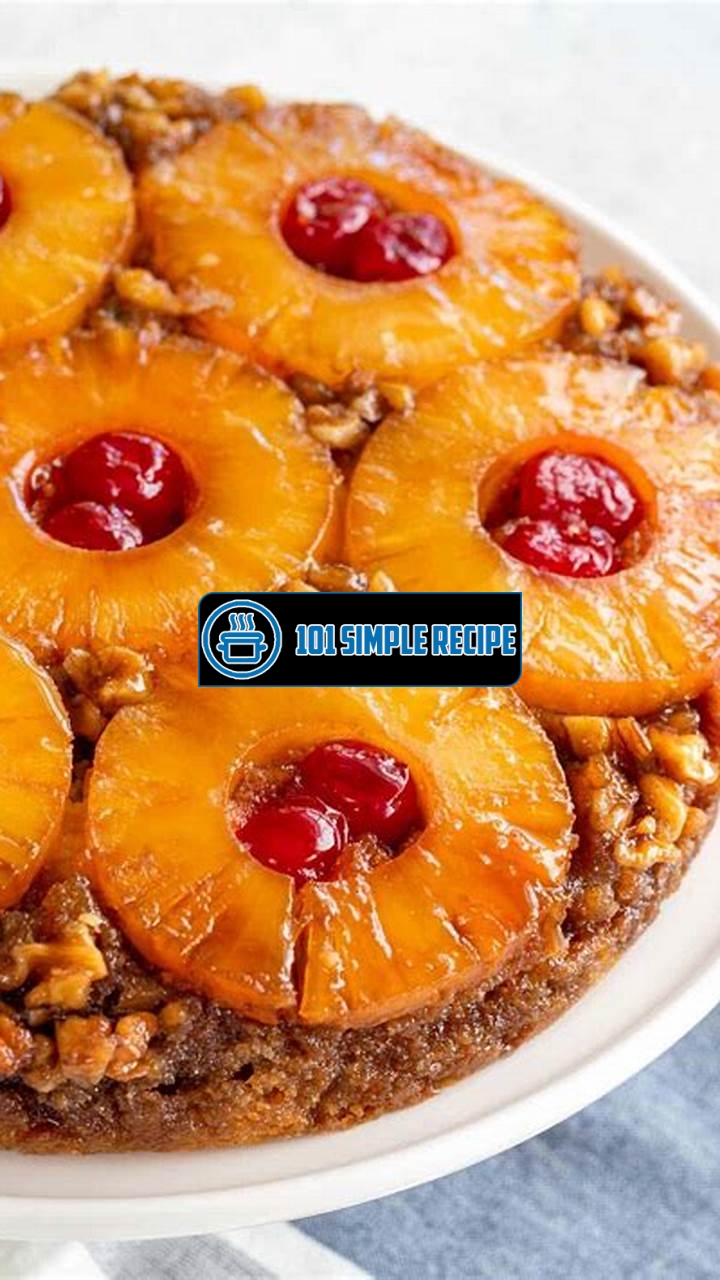Are you craving a deliciously moist and caramelized dessert? Look no further than the perfect recipe for Pineapple Upside Down Cake! ✨ This classic treat combines the sweetness of juicy pineapple slices with a rich buttery cake base, creating a delightful symphony of flavors that will leave your taste buds wanting more. Whether you are a seasoned baker or a novice in the kitchen, this recipe is sure to impress your family and friends. So, get ready to embark on a culinary adventure and let’s dive into creating this mouthwatering Pineapple Upside Down Cake!

The History of Pineapple Upside Down Cake
Discover the origins and evolution of the beloved pineapple upside down cake.
Origins of the Pineapple Upside Down Cake
Explore the history and cultural significance of this classic dessert.
The origins of the pineapple upside down cake can be traced back to the early 20th century, a time when canned pineapple was gaining popularity. It is believed that this delicious dessert originated in the United States, specifically in the southern region, where pineapples were imported from the Caribbean.
The concept of an “upside down” cake is not unique to pineapple. It actually dates back to medieval times when cooks would place fruit at the bottom of a pan and pour cake batter over it. This method allowed the fruit juices to seep into the cake as it baked, resulting in a flavorful and moist dessert.
However, it was in the early 1900s that the pineapple upside down cake as we know it today started to take shape. With the introduction of canned pineapple and the rise of home baking, this sweet treat became a staple in American households.
The pineapple upside down cake became a symbol of hospitality and indulgence, often served during social gatherings and special occasions.
One of the earliest documented recipes for pineapple upside down cake appeared in a 1925 pamphlet by the Hawaiian Pineapple Company, which is now known as Dole. The recipe called for arranging pineapple rings and maraschino cherries at the bottom of a cake pan, pouring a butter and sugar mixture over them, and then adding the cake batter on top.
As the years went by, variations of the pineapple upside down cake emerged. Some recipes included additional ingredients like coconut or nuts, while others experimented with different fruits such as peaches or apples. However, the classic version with its signature pineapple rings and cherries remained the most popular.
The Rise in Popularity
Learn how the pineapple upside down cake gained widespread popularity and became an iconic American treat.
In the mid-20th century, the pineapple upside down cake experienced a surge in popularity. Its sweet and tangy flavors, combined with its visually stunning presentation, made it a hit among both home bakers and professional chefs.
The cake’s popularity was further boosted by its inclusion in popular cooking magazines and cookbooks of the time. These publications featured mouthwatering photos and detailed instructions, inspiring people to recreate this classic dessert in their own kitchens.
- The pineapple upside down cake quickly became a staple in American diners and restaurants, often offered as a nostalgic dessert option.
- It was frequently served at potluck gatherings and family celebrations, showcasing the warm and comforting flavors of home.
- The cake also gained recognition through its appearances in movies, TV shows, and advertisements, solidifying its status as a beloved symbol of American baking.
Modern Variations
Discover unique twists on the traditional recipe and innovative ways to incorporate different flavors.
As with any classic dessert, creative bakers and chefs have found ways to put their own spin on the pineapple upside down cake. These modern variations offer exciting flavor combinations and added layers of complexity.
One popular twist is the addition of coconut to the traditional recipe, bringing a tropical flair to the cake. The subtle nuttiness of the coconut complements the sweetness of the pineapple and adds an extra dimension of flavor.
Another modern variation involves using different fruits in place of pineapple, such as peaches or apples. This provides a fresh take on the upside down cake concept, allowing for seasonal variations and diverse flavor profiles.
For those who crave a more adventurous twist, incorporating spices like cinnamon or cardamom can add a warm and aromatic element to the cake. These spices pair well with the sweetness of the fruit and create a unique sensory experience.
The modern variations of the pineapple upside down cake showcase the versatility and creativity of bakers, offering new and exciting ways to enjoy this classic dessert.
Whether you stick with the traditional version or experiment with modern twists, the pineapple upside down cake remains a beloved treat, cherished for its rich history and delightful flavors.
The Science Behind a Perfect Pineapple Upside Down Cake
Uncover the secrets to baking a pineapple upside down cake with the perfect texture and flavor. This classic cake is a favorite for many, with its caramelized pineapple topping and moist, tender crumb. But what makes a pineapple upside down cake truly perfect? Let’s dive into the science behind it and explore the key factors that contribute to its deliciousness.
The Role of Ingredients in Moisture and Texture
When it comes to achieving a moist and tender cake, the ingredients play a crucial role. Starting with the butter, which provides both flavor and moisture to the cake batter. Make sure to use unsalted butter, as it allows you to control the amount of salt in the recipe. For a richer flavor, you can also consider using browned butter.
The sugar in the batter not only adds sweetness but also helps with moisture retention. Brown sugar works especially well in pineapple upside down cakes, as it adds a hint of caramel flavor that complements the pineapple topping.
Eggs are another essential ingredient that contributes to the cake’s structure and moisture. They provide stability to the batter and help create a tender crumb. To ensure your cake turns out perfectly, make sure the eggs are at room temperature before adding them to the batter.
The addition of buttermilk or sour cream adds both moisture and tang to the cake. These acidic ingredients help tenderize the gluten in the flour, resulting in a softer texture. They also react with the leavening agents, such as baking powder and baking soda, to create a light and fluffy cake.
Lastly, the choice of flour can make a difference in the final texture of the cake. Cake flour has a lower protein content compared to all-purpose flour, which makes it ideal for achieving a tender crumb. If you don’t have cake flour on hand, you can make a substitute by combining all-purpose flour with cornstarch.
The Art of Achieving a Balanced Sweetness
Finding the perfect balance of sweetness is key to a successful pineapple upside down cake. The pineapple provides natural sweetness, but it’s important not to overpower the flavors with excessive sugar. To avoid an overly sugary dessert, consider using fresh, ripe pineapple slices instead of overly sweetened canned pineapple rings.
In addition to the pineapple, the brown sugar used in the topping adds a slightly caramelized sweetness. The acidic nature of the pineapple also helps balance the overall sweetness of the cake. You can enhance this balance by adding a touch of salt to the batter or using a sprinkle of sea salt on top of the caramelized pineapple.
Remember, taste testing along the way is crucial to ensure you achieve the perfect balance of sweetness. Adjusting the amount of sugar or considering alternative sweeteners, such as honey or maple syrup, can also be explored to suit your taste preferences.
Mastering the Baking Techniques
Even if you have the perfect combination of ingredients, mastering the baking techniques is essential to achieving a beautifully baked pineapple upside down cake.
First and foremost, make sure your oven is preheated to the correct temperature specified in the recipe. This ensures that the cake bakes evenly and rises properly. It’s also advisable to use an oven thermometer to ensure the accuracy of your oven’s temperature.
Properly greasing and preparing the cake pan is crucial to ensure the cake turns out intact. Use butter or cooking spray to grease the sides and bottom of the pan, then line the bottom with parchment paper for easy removal.
When arranging the pineapple slices and maraschino cherries on the bottom of the pan, take your time to create an attractive pattern. This will be visible on the top of the finished cake, so it adds to the overall presentation. You can get creative with different designs, such as concentric circles or a decorative pattern.
When it’s time to pour the batter over the pineapple layer, do it slowly and gently to avoid disturbing the arrangement. Using a spatula can help spread the batter evenly and ensure it covers the pineapple slices completely.
While baking, keep an eye on the cake to prevent over or under-baking. A toothpick or cake tester inserted into the center should come out clean or with a few crumbs clinging to it. If the cake is browning too quickly on top, you can tent it with foil to prevent further browning while it finishes baking.
Once the cake is done, remove it from the oven and let it cool in the pan for a few minutes. Then, carefully invert it onto a serving plate or cake stand, so the pineapple and caramelized topping are now on top. Peel off the parchment paper, and voila – your perfect pineapple upside down cake is ready to be enjoyed!
Choosing the Right Pineapple for Your Cake
Navigating the world of pineapples can be overwhelming, as there are different varieties to choose from. However, when it comes to making a delectable pineapple upside-down cake, selecting the right pineapple is crucial. Each variety has its own unique flavor profile, sweetness level, and texture, which can greatly affect the taste and presentation of your cake. To ensure you pick the perfect pineapple, consider the following factors:
- Flavor Profile: Pineapples can range from sweet and tangy to more acidic. Determine your preference and choose a variety that matches your desired flavor profile.
- Sweetness Level: Some pineapples are sweeter than others. If you prefer a cake with a sweeter taste, opt for a variety known for its high sugar content.
- Texture: The texture of pineapples can vary, with some being more fibrous while others are softer and juicier. Consider the texture you want in your cake and choose a pineapple accordingly.
Now that you have a better understanding of the factors to consider, let’s explore some popular pineapple varieties and their characteristics to help you make an informed choice.
Understanding Different Pineapple Varieties
Hawaiian Gold (aka Maui Gold): This variety is known for its exceptional sweetness and low acidity. It has a golden color and a firm texture, making it a great choice for pineapple upside-down cakes. The sweet and juicy flavor of Hawaiian Gold pineapples can elevate the taste of your cake.
Queen Pineapple: Native to Thailand, the Queen pineapple is smaller in size but packs a punch in terms of flavor. It is incredibly sweet, with a slightly tangy taste. The Queen pineapple is often referred to as the “Sugarloaf” pineapple due to its conical shape, and it adds a tropical twist to your cake.
Red Spanish Pineapple: This variety has a vibrant red skin and a bright yellow flesh. It has a mild to moderate sweetness and a slightly acidic taste. The Red Spanish pineapple offers a balance of flavors that work well in pineapple upside-down cakes.
Smooth Cayenne: Smooth Cayenne pineapples are larger in size and have a golden yellow color. They are known for their juiciness and have a pleasant sweet and tangy flavor. This variety is versatile and can be used in various pineapple-based desserts, including upside-down cakes.
Optimal Ripeness for a Sweet and Tangy Cake
When it comes to making a pineapple upside-down cake, selecting a pineapple at its peak ripeness is crucial. A perfectly ripe pineapple will not only enhance the flavor of your cake but also add a natural sweetness and juiciness. So how can you determine if a pineapple is ripe?
First, examine the color of the pineapple. A ripe pineapple will have a vibrant yellow or golden color. Avoid pineapples that are completely green as they are not yet fully ripe. Additionally, the skin of a ripe pineapple should yield slightly when pressed, indicating that it is soft and juicy.
Another technique to determine ripeness is by giving the pineapple a gentle tug. If it easily detaches from the plant, it is likely ripe. Lastly, don’t forget to give it a sniff! A ripe pineapple will have a fragrant tropical aroma.
Preparing the Pineapple for the Cake
Now that you’ve chosen your perfect pineapple, it’s time to prepare it for your upside-down cake. Here is a step-by-step guide:
- Cut: Start by removing the top and bottom of the pineapple. Stand it upright and carefully slice off the skin, ensuring you remove any brown spots. Once peeled, lay the pineapple on its side.
- Core: Slice the pineapple crosswise into rounds, about half an inch thick. To remove the core of each round, use a small round cookie cutter or a sharp knife. This step will ensure that every bite of your cake is free of the tough core.
- Arrange: Take a cake pan and grease it with butter or cooking spray. Arrange the pineapple rounds in the pan, ensuring they cover the entire bottom surface. You can also add maraschino cherries to the center of each pineapple round for added visual appeal.
- Follow the Cake Recipe: At this point, you are ready to follow your preferred pineapple upside-down cake recipe. Pour the cake batter carefully over the pineapple and cherries, ensuring it spreads evenly.
- Bake and Invert: Bake the cake as per the recipe instructions. Once it’s done, remove it from the oven and allow it to cool for a few minutes. To invert the cake, place a serving platter over the pan and confidently turn it over, gently tapping the bottom of the pan to loosen the cake. Lift the pan, and voila! Your pineapple upside-down cake is ready to be enjoyed.
By following these steps, you’ll create an eye-catching and delicious pineapple upside-down cake that will impress everyone at your table.
With the right pineapple variety and proper preparation techniques, you can create a pineapple upside-down cake that is sweet, tangy, and visually stunning. So, don’t hesitate to explore the world of pineapples and take your baking skills to the next level. Happy baking!
Perfecting the Caramelized Topping
Master the art of creating a delectable caramelized topping that complements the pineapple and cake layers.
Choosing the Right Pan and Toppings
When it comes to achieving the perfect caramelized topping for your pineapple upside down cake, choosing the right pan and toppings can make all the difference. The pan you use will affect the heat distribution and the overall texture of the caramel. Opt for a heavy-bottomed pan such as a cast iron skillet or a non-stick cake pan to ensure even cooking and easy release of the finished cake.
As for toppings, the classic combination of pineapple rings and maraschino cherries is always a crowd-pleaser. However, don’t be afraid to get creative and experiment with different fruits or even nuts to add a unique twist to your cake.
Creating a Flawless Caramelization
Creating a perfectly caramelized topping requires a careful balance of heat and timing. Start by melting butter and brown sugar together in your chosen pan over medium heat. Stir continuously until the mixture is smooth and bubbly.
Next, arrange the pineapple rings and cherries in the caramel, making sure they are evenly distributed. Lower the heat slightly to prevent burning and cook the caramelized topping for about 5-7 minutes, or until it turns a rich golden color.
A key tip to achieving a flawless caramelization is to monitor the heat closely. If the caramel starts to darken too quickly, reduce the heat to maintain a steady color. On the other hand, if the caramel is taking too long to develop, increase the heat slightly.
Enhancing the Flavor with Additional Ingredients
While the caramelized topping alone is delicious, you can take it to the next level by incorporating additional ingredients that enhance the flavor. Consider adding a pinch of cinnamon or nutmeg to the caramel mixture for a warm and spicy undertone. Alternatively, try grating some fresh citrus zest, such as orange or lemon, into the caramel for a subtle tang.
Another way to elevate the flavor of your caramelized topping is to experiment with different extracts. A few drops of vanilla or almond extract can add a delightful aroma and depth of flavor to the caramel.
Remember, the key to achieving the perfect caramelized topping for your pineapple upside down cake is practice and experimentation. Don’t be afraid to adjust the heat, timing, or ingredients according to your personal preference. With a little patience and creativity, you’ll soon master the art of creating a truly irresistible caramelized topping that will take your cake to new heights.
Presenting and Serving the Pineapple Upside Down Cake
You’ve mastered the art of baking a delicious pineapple upside down cake, and now it’s time to take your dessert game to the next level by presenting and serving this classic treat with style and creativity. Whether you’re hosting a dinner party or simply want to impress your family and friends, these tips and techniques will help you create a memorable experience for everyone.
Plating and Garnishing for Visual Appeal
When it comes to plating and garnishing your pineapple upside down cake, the goal is to create a stunning and visually appealing presentation. Start by choosing a beautiful cake platter or plate that complements the colors and flavors of the cake. A simple, white platter can provide an elegant backdrop for the vibrant colors of the pineapple, cherries, and caramelized brown sugar.
To add an extra touch of elegance and visual interest, consider garnishing your cake with fresh fruits or edible flowers. Slices of fresh pineapple, cherries, or even a sprig of mint can elevate the presentation and make your dessert the star of the show. Don’t be afraid to get creative and experiment with different garnishes to find the perfect combination that suits your personal style.
Accompaniments and Pairings for a Complete Experience
The pineapple upside down cake is delicious on its own, but pairing it with the right accompaniments and beverages can elevate the overall enjoyment of this classic dessert. Consider serving a dollop of whipped cream or a scoop of vanilla ice cream alongside each slice of cake to add creaminess and balance out the sweetness.
If you’re feeling adventurous, you can also experiment with different beverage pairings to complement the flavors of the cake. A cup of aromatic coffee or a glass of cold milk can provide a nice contrast to the rich and sweet flavors of the cake. For those who prefer something stronger, a glass of rum or a fruity cocktail can enhance the tropical notes of the pineapple and add a touch of sophistication to your dessert experience.
Storage and Reheating Tips
After indulging in a slice or two of pineapple upside down cake, you may find yourself with leftovers. To ensure that your cake stays fresh and delicious, proper storage and reheating techniques are essential. Start by allowing the cake to cool completely before wrapping it tightly in plastic wrap or storing it in an airtight container. This will prevent the cake from drying out and help maintain its moist texture.
When it comes to reheating the cake, there are a few methods you can try. One option is to place individual cake slices on a microwave-safe plate and heat them in the microwave for about 30 seconds to 1 minute, or until warm. Another option is to wrap the cake in foil and warm it in a low oven for about 10-15 minutes. Both methods will help restore the cake’s freshness and bring out the flavors.
Remember that proper storage and reheating can only preserve the cake for a limited time. It’s best to consume the leftovers within a few days to enjoy the cake at its best.
By mastering the art of presenting and serving the pineapple upside down cake, you can create a dessert experience that is not only delicious but also visually stunning. From plating and garnishing to choosing the right accompaniments and reheating techniques, these tips will help you take your pineapple upside down cake to new heights. So go ahead, get creative, and enjoy every sweet and fruity bite of this classic treat!
Thank you for taking the time to read our article about pineapple upside down cake. We hope you found it informative and helpful in your baking endeavors. If you have any questions or suggestions, please feel free to reach out to us. We are always here to assist you in any way we can. Don’t forget to bookmark our page and visit again later for more delicious recipes and baking tips.
Frequently Asked Questions
Here are some frequently asked questions about pineapple upside-down cake:
| No. | Questions | Answers |
|---|---|---|
| 1. | What are the main ingredients needed for pineapple upside-down cake? | The main ingredients for pineapple upside down cake include pineapple slices, maraschino cherries, brown sugar, butter, and cake batter. |
| 2. | How do I properly arrange the pineapple slices and cherries? | To arrange the pineapple slices and cherries, place a cherry in the center of each pineapple slice and place them on the bottom of the cake pan. |
| 3. | Can I use fresh pineapple instead of canned pineapple? | Yes, you can use fresh pineapple instead of canned pineapple. Just make sure to slice it thinly and remove the core. |
| 4. | How long does pineapple upside-down cake need to cool before serving? | It is best to let the pineapple upside down cake cool for about 10-15 minutes before serving to allow the flavors to meld together. |
| 5. | Can I store leftover pineapple upside-down cake? | Yes, you can store leftover pineapple upside-down cake in an airtight container in the refrigerator for up to 3-4 days. |
| 6. | Can I make pineapple upside-down cake in advance? | Yes, you can make pineapple upside-down cake in advance. Just make sure to store it properly and reheat it before serving if desired. |
Happy Baking!
We hope you enjoy baking and indulging in a delicious pineapple upside down cake. Don’t hesitate to explore our other recipes for more culinary adventures. Remember to share your creations with us and let us know how they turned out. Happy baking!
Jump to Recipe
Pineapple Upside Down Cake

A classic recipe for pineapple upside down cake that is sure to impress. The sweet caramelized pineapple and cherries on top of a moist vanilla cake will melt in your mouth.
- 1/2 cup unsalted butter
- 1 cup packed brown sugar
- 1 can pineapple slices (20 ounces, drained)
- 1/4 cup maraschino cherries
- 1 1/2 cups all-purpose flour
- 1 cup granulated sugar
- 1/2 cup buttermilk
- 1/4 cup vegetable oil
- 1 1/2 teaspoons baking powder
- 1 teaspoon vanilla extract
- 1/2 teaspoon salt
- 2 large eggs
- Preheat the oven to 350°F (175°C) and grease a 9-inch round cake pan.
- In a small saucepan, melt the butter over low heat. Once melted, pour it into the greased cake pan and sprinkle the brown sugar evenly over the butter.
- Arrange the pineapple slices on top of the butter and sugar mixture. Place a cherry in the center of each pineapple slice.
- In a mixing bowl, combine the flour, granulated sugar, buttermilk, vegetable oil, baking powder, vanilla extract, salt, and eggs. Mix until well combined.
- Pour the cake batter over the pineapple and cherries in the cake pan, spreading it evenly.
- Bake the cake in the preheated oven for 45 minutes, or until a toothpick inserted into the center comes out clean.
- Allow the cake to cool in the pan for 10-15 minutes. Then, invert the cake onto a serving plate, carefully lifting off the pan.
- Slice and serve the pineapple upside down cake while still warm. Enjoy!






